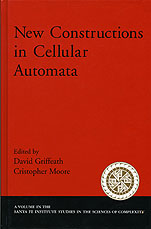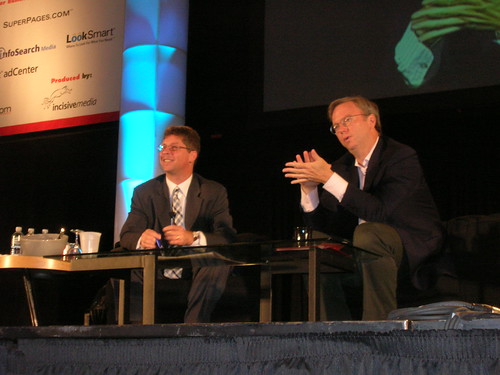Yes, you can automate SEO – we’ve done it!
Loren Baker at Search Engine Journal wrote a post highlighting Commerce360’s stated intention to build automatic optimization software, using a lot of venture capital they raised for this purpose. Loren asks, “Can SEO Be Automated?”
Inspired by this thread, Lisa Barone at Bruce Clay, Inc. responds with “You Can’t Automate Search Engine Optimization” (which is just the tiniest bit ironic, since Bruce Clay’s Dynamic Site Mapping tool arguably provides a level of automated search optimization).
While Commerce360 is looking to create search optimization automation, we’ve already been accomplishing it for quite some time here at Netconcepts, as I outlined in an earlier article on Automatic Search Engine Optimization. So, do I think SEO can be automated? Hell, yes!
Possible Related Posts
Posted by Chris of Silvery on 09/21/2007
Permalink | |  Print
| Trackback | Comments Off on Yes, you can automate SEO – we’ve done it! | Comments RSS
Print
| Trackback | Comments Off on Yes, you can automate SEO – we’ve done it! | Comments RSS
Filed under: HTML Optimization, Marketing, Monetization of Search, Search Engine Optimization, SEO, technology, Tools Automatic-Search-Engine-Optimization, Automatic-SEO, GravityStream, Netconcepts, SEO, SEO-Web-Services
Misguided Science Fiction Writers Advise U.S. on Homeland Security
 USA Today has reported in “Sci-fi writers join war on terror” that a small group of science fiction writers have been contacted by the U.S. government to advise on new and innovative ways that security could be improved. The group, called Sigma, was formed about 15 years ago by writer Arlan Andrews and was specifically intended to advise the government on advanced technology issues.
USA Today has reported in “Sci-fi writers join war on terror” that a small group of science fiction writers have been contacted by the U.S. government to advise on new and innovative ways that security could be improved. The group, called Sigma, was formed about 15 years ago by writer Arlan Andrews and was specifically intended to advise the government on advanced technology issues.
Their motto seems ominous in context of recent-history political trends and frighteningly nationalistic: “Science Fiction in the National Interest“. I think their involvement is a bit horrifying, misguided, and more than a bit egotistically self-grandiose. Read on for more details.
Possible Related Posts
Posted by Chris of Silvery on 05/31/2007
Permalink | |  Print
| Trackback | Comments Off on Misguided Science Fiction Writers Advise U.S. on Homeland Security | Comments RSS
Print
| Trackback | Comments Off on Misguided Science Fiction Writers Advise U.S. on Homeland Security | Comments RSS
Filed under: Futurism, News, Security, technology Arlan-Andrews, Eric-Kotani, Greg-Bear, Homeland-Security, Jerry-Pournelle, Larry-Niven, Sage-Walker, science-fiction, Sigma-Group
How Web 2.0 Affects SEO Strategy
My colleague, P.J. Fusco just wrote a great article over at ClickZ on How Web 2.0 Affects SEO Strategy. In it, she provides a good overview of what’s good and bad about “Web 2.0” stuff, and how some of the technology involved can challenge the goal of natural search optimization of a website. It’s well worth a read if you’re unfamiliar with these issues.
Possible Related Posts
Posted by Chris of Silvery on 05/23/2007
Permalink | |  Print
| Trackback | Comments Off on How Web 2.0 Affects SEO Strategy | Comments RSS
Print
| Trackback | Comments Off on How Web 2.0 Affects SEO Strategy | Comments RSS
Filed under: SEO, technology AJAX, SEO, Social-Media, Web-2.0
The Game of Life: New Chromatic Projection Method
I’ve been interested in The Game of Life ever since I heard about it back in the 70s/80s. It was some time around when my dad bought us our first personal computers. The Game of Life was invented by the mathematician, John Horton Conway, as he worked upon a way of modeling life-like behaviors within a simple field of rules. Conway’s Game of Life was popularized by Martin Gardner — the well-known writer of a popular science column in Scientific American.
Tons of hobbyists and computer programmers cut their eye-teeth by playing the Game of Life through programs copied out of magazines onto their PCs. I recall copying one of these programs out of a computer magazine into either our Timex-Sinclair 1000 or Commodore 64. I can’t recall whether it was Dr. Dobb’s or one of the myriad specialty Commodore zines that my dad was always buying.

Anyway, my aunt Amelia recently gave me a book for Christmas from my Amazon want list – it was New Constructions in Cellular Automata (Santa Fe Institute Studies in the Sciences of Complexity Proceedings)
— a few different papers all nicely bound up by the Santa Fe Institute. (I’m a big fan of quite a few theories regarding Complexity, Economics, Biology, etc which have come out of the Santa Fe Institute.) After looking over the papers from various researchers that have studied different aspects of Cellular Automata, I started thinking that it could be worthwhile to set up the Game of Life with some color/display elements which can help with predictive display of Life grouping evolution. I’ve written a little program that does this, so read on if you’re interested.

Glider Pattern animated
with color path projection
Possible Related Posts
Posted by Chris of Silvery on 02/14/2007
Permalink | |  Print
| Trackback | Comments Off on The Game of Life: New Chromatic Projection Method | Comments RSS
Print
| Trackback | Comments Off on The Game of Life: New Chromatic Projection Method | Comments RSS
Filed under: Dynamic Sites, General, technology cellular-automata, game-of-life, John-Conway, Martin-Gardner, The-Game-of-Life
Dr. Paul W.K. Rothemund and Dr. Eric Winfree awarded the Feynman Prize at nanoTX Conference
Dr. Paul W.K. Rothemund and Dr. Eric Winfree were awarded the 2006 Foresight Institute Feynman Prizes at the nanoTX Conference last week, at a special awards reception. (I earlier blogged about H. Ross Perot’s keynote address at this conference.)
Rothemund was on-hand to receive the award, and I was fortunate to be able to attend his presentation on his and Winfree’s research. Rothemund delivered first a presentation on his work, and then he delivered a presentation on behalf of Winfree who could not attend.
Rothemund’s work is fantastic — he works upon Algorithmic Self-Assembly. He’s been able to program long strands of viral DNA such than when mixed in a suspension with other short DNA snippets (and heated slightly), the snippets or “staples” will bind to the long strand in particular order, causing it to fold back upon itself to form precise shapes. Rothemund has nicknamed what he does as “DNA Origami”, although the key concept is the ability to program the DNA to order itself into near two-dimensional, or even three-dimensional shapes. As proof of concept, Rothemund has programmed DNA to fold itself into words, stars, smiley faces, and other shapes.

Smiley composed of one long DNA strand
The staple snippets of DNA are not shown in this representation.
(Illustration copyright 2006 by Chris Silver Smith.)
Possible Related Posts
Posted by Chris of Silvery on 10/02/2006
Permalink | |  Print
| Trackback | Comments Off on Dr. Paul W.K. Rothemund and Dr. Eric Winfree awarded the Feynman Prize at nanoTX Conference | Comments RSS
Print
| Trackback | Comments Off on Dr. Paul W.K. Rothemund and Dr. Eric Winfree awarded the Feynman Prize at nanoTX Conference | Comments RSS
Filed under: Futurism, General, technology Algorithms, artificial-intelligence, DNA, future, Futurism, nano, nanotech
Governor Rick Perry & H. Ross Perot open Nanotech Conference, nanoTX ’06
Yesterday morning, Governor Rick Perry and H. Ross Perot each gave opening remarks at the nanoTX nanotechnology conference here in Dallas.
Kelly Kordzik (President of the board of the Texas Nanotechnology Initiative organization), and Rich Templeton (CEO of Texas Instruments) each gave some introductory remarks. Templeton’s talk was interesting, touching on work done by TI, and on how Nanotech is still in its infancy and very much dependent upon government investment/support. Governor Rick Perry spoke for a short while, mainly trying to hype up his support of the Texas Emerging Technology Fund which has enabled a lot of research in the field of nanotech, enabling Texas to be on the leading end of the work, worldwide.
Read on for more details…
Possible Related Posts
Posted by Chris of Silvery on 09/28/2006
Permalink | |  Print
| Trackback | Comments Off on Governor Rick Perry & H. Ross Perot open Nanotech Conference, nanoTX ’06 | Comments RSS
Print
| Trackback | Comments Off on Governor Rick Perry & H. Ross Perot open Nanotech Conference, nanoTX ’06 | Comments RSS
Filed under: Futurism, General, technology future, Futurism, nanotech
Will Google Keep Minority Report from Happening? Eric Schmidt’s Chat with Danny Sullivan
This morning at the Search Engine Strategies Conference 2006 in San Jose, Danny Sullivan interviewed the Google CEO, Eric Schmidt, in the conference’s main keynote session. Others such as the Search Engine Roundtable have reported on most of the content of that session, but one little thing Danny mentioned particularly grabbed my attention. Read on, and I’ll elaborate….
Possible Related Posts
Posted by Chris of Silvery on 08/09/2006
Permalink | |  Print
| Trackback | Comments Off on Will Google Keep Minority Report from Happening? Eric Schmidt’s Chat with Danny Sullivan | Comments RSS
Print
| Trackback | Comments Off on Will Google Keep Minority Report from Happening? Eric Schmidt’s Chat with Danny Sullivan | Comments RSS
Filed under: Conferences, Futurism, General, Google, Security, technology cyberpunk, danny-sullivan, Eric-Schmidt, Google, Philip-K.-Dick, PKD, privacy, SES-Conference
Through the Scanner Darkly
Seems strange, but there are only two degrees of separation between me and the late, famous, science fiction author, Philip K. Dick (“PKD”). If you aren’t familiar, Dick was the author of a number of stories which have since been made into major films such as: Blade Runner, Total Recall, Minority Report, and the recently-released film A Scanner Darkly. I’ve just got two degrees of separation from Philip K. Dick because of my “spare time” work on writing a soon-to-be-published book about two of his friends and protégés, Tim Powers and James P. Blaylock. In the course of writing that book, (A Comprehensive Dual Bibliography of James P. Blaylock & Tim Powers), I asked the authors questions about their old friend, Dick, and I spoke with other friends of his as well. He was apparently a very interesting character — brilliant, and more than a bit mysterious as well. PKD had a few unusual religious visions and appeared to suffer occasionally from paranoia and other schizophrenic bouts.
Last weekend, I got to see the most recent film inspired by a Philip K. Dick story, A Scanner Darkly, directed by Richard Linklater. The film was really great, telling a futuristic story of an undercover cop who becomes addicted to the drug of choice for his surveillance subjects, and then becomes required to spy on himself in the course of his investigation. The undercover cops all wear these camouflage suits which morph together features from millions of individuals to obscure their identies from others and from each other. The film is astoundingly well-made, and is pretty entertaining overall.
I saw that Nelson Minar, one of Google’s engineers, is also apparently a reader of PKD, and he blogged his impressions about A Scanner Darkly, too. He agrees that it’s good, though I disagree with him: he thinks it won’t appeal to people who haven’t read the book, and I think it will. It strikes too many chords with people, even today, and the actor’s humor in the early parts saves it from being too dry/boring.
Dick’s stories still seem relevant, over twenty years after his death. His stories contrasted realistic characters against a twisted reality where commercialism and technology seem to’ve evolved past a reasonable point. He played around with the nature of reality itself, and his work seemed to segue smoothly into the cyberpunk movement, which I previously posted about.
Possible Related Posts
Posted by Chris of Silvery on 07/18/2006
Permalink | |  Print
| Trackback | Comments Off on Through the Scanner Darkly | Comments RSS
Print
| Trackback | Comments Off on Through the Scanner Darkly | Comments RSS
Filed under: Futurism, General, Security, technology A-Scanner-Darkly, artificial-intelligence, biometrics, camouflage-suit, cyberpunk, flexible-display-screens, Futurism, James-P.-Blaylock, Minority-Report, nanotech, Philip-K.-Dick, PKD, science-fiction, Susumu-Tachi, Tim-Powers, Turing-tests



